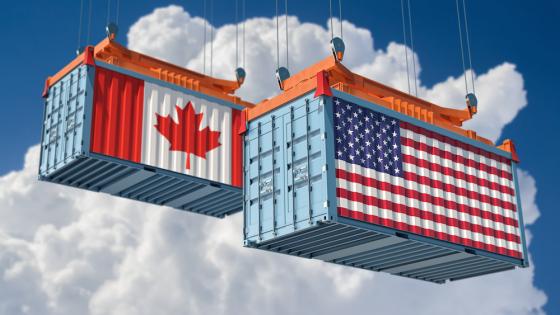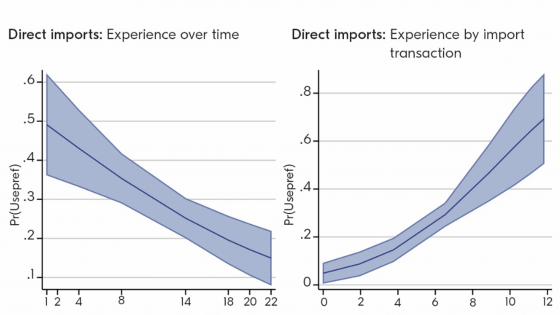Academic and political thinking about free trade agreements (FTAs) has been concerned about the potential harm to outsiders from trade diversion since Jacob Viner clarified the issues more than 60 years ago (Viner 1950). But economists are still not clear on the magnitude of trade diversion.
- How large is the harm from trade diversion?
- Does the gain to current FTA partners from trade diversion create a stumbling block to further expansion because that gain would have to be given up?
These are questions that are still up in the air even after 60 years of attention. Recent research sheds new light on these questions.
The basic economic logic
Free trade agreements divert trade from outsiders to insiders because the relative cost of insider business falls. Tariffs between partners disappear while remaining in place for non-partners. More important in the modern setting of already low tariffs are the non-tariff barriers that fall between partners as regulatory barriers are reduced and the greater security of trade relations stimulates potential traders to invest in deals with insider counter-parties. Baldwin (2011) describes how recent FTAs are deeper than tariff agreements.
In order to assess trade diversion and its effects through non-tariff barrier reductions, we need an empirical analysis of trade flows before and after implementation of FTAs. Our recent work tackles these questions (Anderson and Yotov 2011). Our findings are reassuring.
- FTAs provide gains to partners, large for the smaller partners, while inflicting very small losses on outsiders.
- Regional trade agreements appear to be building blocks rather than stumbling blocks.
- Direct gains to new partners are big, while indirect effects on outsiders are small.
Earlier efforts at empirical assessment of the effect of FTAs were hampered by the endogeneity problem – FTAs form between partners who already trade a lot with each other. Baier and Bergstrand (2007) satisfactorily resolve the endogeneity problem by applying panel data methods due to Wooldridge (2002). Using a gravity model of aggregate bilateral trade flows, they report that fully phased-in FTAs double the bilateral trade of partners relative to non-partners, a large effect consistent with a large reduction of non-tariff barriers.
The economic harm from trade diversion is due to deterioration in the outsiders’ terms of trade, i.e. the price of their exports relative to their imports. Export prices of outsiders tend to fall to clear their reduced markets while import prices of outsiders tend to rise as supplies are diverted to insiders. International price comparisons before and after FTAs can shed light on this, but they are hampered by the great difficulty of obtaining internationally comparable price data (Chang and Winters, 2002) as well as the issue of inferring FTA causation from observed price changes. Our recent research reports on the terms-of-trade effects implied by implementation of the FTAs of the 1990s in two-digit manufacturing sectors for 40 countries and a rest-of-the-world aggregate. We build on the gravity approach of Baier and Bergstrand to infer direct volume effects and then use the full implications of the structural gravity model to infer price changes. We also calculate the implied change in efficiency of world trade. Drawing out the iceberg-melting metaphor of trade costs, 0.62% less of the iceberg melts due to the 1990s' FTAs.
Methods and evidence
The gravity model has become widely accepted among trade economists because it fits well and its theoretical foundations are plausible and appear to be consistent with the data (Anderson 2011). Essentially, trade costs are implied by bilateral trade flows that deviate from what would otherwise be predicted from the characteristics of importer and exporter countries, empirically captured as time-varying fixed effects. The deviation is fitted to proxies for bilateral frictions such as distance and the presence or absence of FTAs. Controlling for all time-invariant bilateral frictions such as distance with bilateral fixed effects in a panel setting, following Baier and Bergstrand, it is possible to consistently estimate the trade flow effects of FTAs and customs unions that come into effect, in our case between 1990 and 2002.1
An important issue with inferring the terms-of-trade effects of FTAs from the volume effects is that the direct bilateral trade diversion affects all multilateral trade relations in the world. The country-time fixed effects capture the inward and outward multilateral resistance each buyer and seller faces in trading with the world, which change with the implementation of FTAs even for countries not involved. The structural gravity model is a general equilibrium model of distribution that permits measuring these indirect effects, hence we use a structural gravity in combination with the estimated FTA volume effects to simulate the price effects of FTAs implemented in the 1990s. The striking confirmation of the structural gravity we report in Anderson and Yotov (2010) justifies the heavy reliance on the model structure needed for the simulation.
Table 1 reports our FTA terms-of-trade effects (column 3) and decomposes FTA price incidence on the producers (column 1) and the consumers (column 2) for selected economies, including Australia, China, Japan, and South Korea as the only countries (outsiders) in their sample that did not enter any FTA during the period 1990-2002.
Table 1. FTA Effects, 1990-2002
|
Country
|
Producers
|
Consumers
|
ToT Effects
|
|
Bulgaria
|
5.272
|
-5.209
|
11.079
|
|
|
(0.165)
|
(0.155)
|
(0.349)
|
|
Canada
|
-0.126
|
-0.179
|
0.043
|
|
|
(0.004)
|
(0.006)
|
(0.002)
|
|
China
|
-0.6
|
-0.355
|
-0.18
|
|
|
(0.019)
|
(0.012)
|
(0.006)
|
|
Germany
|
0.412
|
-0.16
|
0.512
|
|
|
(0.018)
|
(0.007)
|
(0.016)
|
|
UK
|
-0.186
|
-0.486
|
0.259
|
|
|
(0.006)
|
(0.016)
|
(0.009)
|
|
Hungary
|
5.513
|
-6.857
|
13.192
|
|
|
(0.16)
|
(0.217)
|
(0.425)
|
|
Japan
|
-0.527
|
-0.377
|
-0.074
|
|
|
(0.02)
|
(0.014)
|
(0.003)
|
|
S. Korea
|
-0.509
|
-0.31
|
-0.125
|
|
|
(0.017)
|
(0.012)
|
(0.004)
|
|
Mexico
|
3.319
|
-4.322
|
7.593
|
|
|
(0.093)
|
(0.134)
|
(0.22)
|
|
Poland
|
7.31
|
-7.701
|
16.112
|
|
|
(0.207)
|
(0.246)
|
(0.521)
|
|
Uruguay
|
2.093
|
-4.438
|
7.451
|
|
|
(0.072)
|
(0.124)
|
(0.22)
|
|
USA
|
-0.087
|
-0.158
|
0.054
|
|
|
(0.005)
|
(0.006)
|
(0.002)
|
Notes: This table reports terms-of-trade effects and their incidence on consumers and producers due to integration during the 1990s. Standard errors are reported in parentheses. See Anderson and Yotov (2011) for further details.
On the producer side, the biggest winners are relatively small European and Latin American economies (e.g. Poland, Hungary, and Mexico) that signed FTAs with large trading partners. Outsiders are among the biggest losers, but producers in some developed countries suffer moderate losses as well (see the US and Canada for example). The gains for the winners might be at the expense of the losers. Trade diversion explains why losers lose, while the gainers’ gains are partly due to the shift from the losers and partly due to a direct benefit of lower trade costs due to the FTA – in effect a transfer from nature.
Without exception, buyers in the world benefited from the trade integration of the 1990s. See column 2. Importantly, even consumers in nations that did not enter any free trade agreement during the period of investigation enjoy lower prices. Trade diversion (coming from both domestic producers who have lost access to foreign markets and from more efficient foreign producers) may explain the fall of prices for outside consumers. In addition, consumer gains dominate producer losses, if any, and translate into a terms-of-trade improvement for all member countries. Even though producers in some nations are hurt, FTAs provide net gains to all partners. The only nations that suffer economically small but statistically significant net terms-of-trade losses are the outsiders that stayed out of integration during the 1990s. This could potentially incite them to enter FTAs and thus establish the role of FTAs as building blocks.
In our research we further use structural gravity to extend the iceberg-melting metaphor to a scalar aggregate (first at the commodity level and then at the world level). The numbers in Table 2 are measures of efficiency gains or, intuitively, the decrease (in absolute value) in “melting” between origin and destination due to FTAs.
Table 2. Global efficiency indices, 1990-2002.
|
Product
|
%∆1994
|
%∆1998
|
%∆2002
|
|
Food
|
0.18
|
0.457
|
0.683
|
|
|
(0.001)
|
(0.001)
|
(0.001)
|
|
Textile
|
0.395
|
1.24
|
2.056
|
|
|
(0.001)
|
(0.002)
|
(0.004)
|
|
Wood
|
0.001
|
0.126
|
0.548
|
|
|
(0.001)
|
(0.001)
|
(0.001)
|
|
Paper
|
-0.003
|
-0.001
|
0.164
|
|
|
(0.001)
|
(0.001)
|
(0.001)
|
|
Chemicals
|
0.07
|
0.252
|
0.524
|
|
|
(0.001)
|
(0.001)
|
(0.001)
|
|
Minerals
|
-0.017
|
0.011
|
0.113
|
|
|
(0.001)
|
(0.001)
|
(0.001)
|
|
Metals
|
0.217
|
0.524
|
0.967
|
|
|
(0.001)
|
(0.001)
|
(0.001)
|
|
Machinery
|
0.054
|
0.229
|
0.478
|
|
|
(0.001)
|
(0.001)
|
(0.001)
|
|
Manufacturing
|
.102
|
.328
|
.622
|
|
|
(0.001)
|
(0.001)
|
(0.001)
|
Note: This table reports global efficiency measures for each sector and aggregate manufacturing. Standard errors are reported in parentheses. See Anderson and Yotov (2011) for procedures used to obtain the efficiency indices and their standard errors.
According to these numbers, all manufacturing sectors enjoy statistically significant efficiency gains, which combine to a global efficiency index for the world of 0.62%. It is also interesting to note that for each sector, as well as for global manufacturing, we see that the numbers in Table 2 increase over time, which may be due to new FTAs or to phasing-in effects of existing FTAs.
Building block vs. stumbling block
The future expansion of FTAs appears unlikely to be hampered by insiders having to give up important previous gains at the expense of outsiders. Our findings of very small terms-of-trade losses to outsiders reported in Table 1, less than 0.2%, suggest that such potential stumbling blocks would be too small to notice while the size of the direct benefits in Table 1 to partners that join suggest much larger building blocks.
We provide further evidence of this overall effect in a counterfactual analysis by removing Mexico from NAFTA, reverting to the previous Canada-US FTA. In that scenario, all parties lose, while Mexico’s loss is larger by far, wiping out over 80% of its 7.6% terms-of-trade gain from its 1990s FTA implementations.
References
Anderson, James E (2011), “The Gravity Model”, Annual Review of Economics, 3, forthcoming.
Anderson, James E and Yoto V. Yotov (2011), “Terms of Trade and Global Efficiency Effects of Free Trade Agreements, 1990-2002”, NBER Working Paper 17003.
Anderson, James E. and Yoto V Yotov (2010), “Specialization: Pro- and Anti-globalising, 1990-2002”, NBER Working Paper 14423.
Baldwin, Richard (2011), “21st Century Regionalism: Filling the gap between 21st century trade and 20th century trade rules”, Graduate Institute, Geneva.
Baier, Scott L and Jeffrey H Bergstrand (2007), ”Do free trade agreements actually increase members' international trade?”, Journal of International Economics, 71(1):72-95.
Chang, Won and L Alan Winters (2002), “How Regional Blocs Affect Excluded Countries: The Price Effects of MERCOSUR”, American Economic Review, 92:889-902.
Viner, Jacob (1950), The Custom Union Issue, Carnegie Endowment for International Peace.
Wooldridge, Jeffrey M (2002), Econometric Analysis of Cross Section and Panel Data, MIT Press.
1 FTAs and customs unions played a significant role in shaping bilateral trade relationships in the world during the 1990s. In the sample we use, 12.5% of all possible bilateral links and 11.5% of bilateral trade were subject to new FTAs and/or customs unions during the period 1990-2002. The effect was stronger in some sectors, such as paper products with 22% of trade affected, and smaller in others, such as food with 9.1% of bilateral trade being subject to new FTAs.


